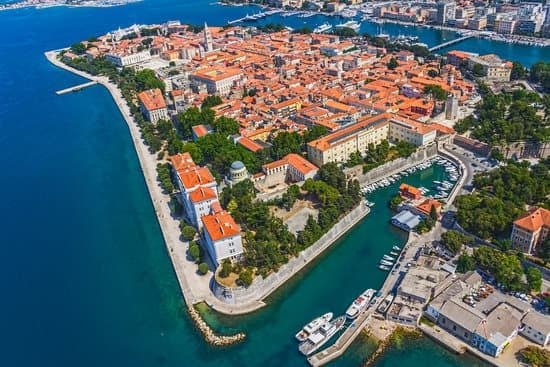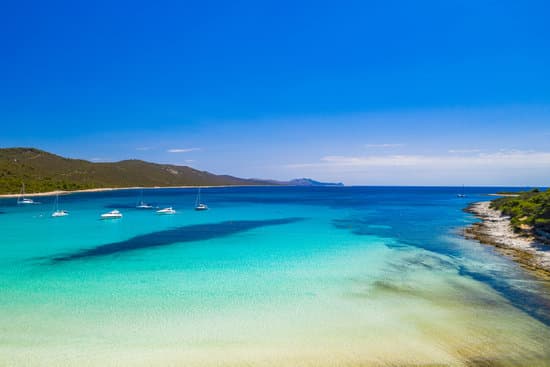Zadar
Zadar ist eine historische Küstenstadt in Kroatien, die für ihre malerische Altstadt, antike römische Ruinen und atemberaubende Aussicht auf die Küste bekannt ist. Entdecken Sie den Charme dieses verborgenen Juwels an der Adria mit unserem Reiseführer für Zadar.

Welcome to the Zadar Riviera, a captivating stretch of coastline nestled along the Adriatic Sea in Croatia. The Zadar Riviera encompasses a diverse range of landscapes, cultural treasures, and recreational opportunities. With its stunning natural beauty, rich history, and warm Mediterranean climate, the Zadar Riviera beckons travelers from around the globe. This unique area is surrounded by Whether you seek serene beaches, ancient ruins, vibrant festivals, delectable cuisine, or thrilling outdoor adventures, this region promises an unforgettable experience for every visitor.
Whether you crave relaxation by the sea, culinary delights featuring local specialties like Pag cheese and Maraschino liqueur, adrenaline-pumping activities such as windsurfing or rock climbing, or exploration of historic sites like the Roman Forum and medieval churches, the Zadar Riviera has something for everyone. Consult our destination guide and embark on the journey of a lifetime!
While Zadar is renowned as the fourth-largest city in Croatia and the historical capital of Dalmatia, its significance stretches far beyond its size. The city boasts a rich history dating back over 3,000 years, shaped by influences from the Romans, Venetians, and Byzantines. One of its most iconic landmarks is the Sea Organ, an innovative art installation that harnesses the power of the sea to create hauntingly beautiful melodies. Legend has it that Zadar derived its name from the ancient Illyrian word "Jadera," meaning "giver of gifts." Indeed, the city has bestowed countless treasures upon its inhabitants and visitors alike, from its breathtaking sunsets over the Adriatic to its vibrant cultural scene and warm hospitality. The historic center of Zadar, with its labyrinthine streets and centuries-old buildings, is a testament to the city's enduring charm. Designated as a UNESCO World Heritage Site, it serves as a living museum of Dalmatian architecture and culture, with landmarks such as St. Donatus Church and the Cathedral of St. Anastasia.
BEACHES ON ZADAR RIVIERA
KOLOVARE BEACH
Situated near the center of Zadar, Kolovare Beach is a well-maintained pebble beach with clear blue waters and a long shoreline, making it ideal for long walks and sunbathing. It's equipped with various facilities including showers, changing rooms, and lifeguards, ensuring a comfortable and safe experience for all visitors. The beach also features beach volleyball courts, and a number of cafes and bars along the promenade, where visitors can enjoy local snacks and drinks. The proximity to Zadar’s historic center allows beachgoers to combine a day of relaxation with some cultural exploration, visiting nearby ancient Roman ruins and medieval churches. Kolovare Beach is definitely a favorite for both locals and tourists, providing a perfect spot to enjoy the Adriatic Sea without straying far from the urban amenities of Zadar.
PUNTA SKALA BEACH
Situated near the resort town of Petrčane, Punta Skala Beach offers a blend of natural beauty and modern amenities. The beach features a mix of sandy and pebbly areas, along with clear waters perfect for swimming and snorkeling. Visitors can rent sun loungers and umbrellas or enjoy refreshments at beachside cafes.
NIN LAGOON
Just a short drive from Zadar, Nin Lagoon is renowned for its shallow, sandy beaches and therapeutic mud. Families flock here for its child-friendly environment, while windsurfers and kiteboarders take advantage of the area's favorable wind conditions. The lagoon's shallow waters warm up quickly, making it an ideal spot for early and late-season swimming.
QUEEN’S BEACH

Queen's Beach, known as "Kraljičina plaža" in Croatian, is part of the Nin Lagoon area. It's one of the most famous beaches in the vicinity and is particularly renowned for its natural setting and medicinal mud, which is believed to have therapeutic properties. This expansive sandy beach offers a stunning view of the Velebit mountain range and is ideal for families due to its shallow waters. The mud found near Queen’s Beach has been used for wellness and medicinal purposes for centuries, making it a popular spot not just for swimming and sunbathing, but also for health treatments. The beach is especially suitable for children and non-swimmers due to its warm, shallow waters.
ZATON BEACH
Zaton Beach is a picturesque stretch of coastline dotted with small coves and sandy areas. Its calm, shallow waters make it suitable for families with children, while water sports enthusiasts can enjoy activities like kayaking and paddleboarding. Visitors can also explore nearby cafes and restaurants serving fresh seafood dishes.
D-MARIN BEACH
This beach is particularly appealing due to well-maintained facilities and beautiful setting. It offers a comfortable and upscale beach experience to its visitors. The beach area is meticulously maintained with clear water and fine pebbles. Visitors can enjoy a variety of amenities such as sun loungers, parasols, and a beach bar. The marina setting adds a unique nautical charm with the view of moored yachts. Additionally, the proximity to the marina Dalmatia allows visitors access to additional facilities such as restaurants and shops.
SAKARUN BEACH

Located on Dugi Otok Island, Sakarun Beach boasts pristine white sands and crystal-clear turquoise waters. It's a perfect spot for families and those seeking relaxation, with shallow waters ideal for swimming and sunbathing. The surrounding pine forest offers shade and a picturesque backdrop. Access to Sakarun Beach is relatively straightforward, with options to arrive by car, island’s bus lines, or even by boat. For those traveling by car, there is a designated parking area a short walk from the beach. This makes it convenient for visitors to bring along picnic supplies or beach gear. Additionally, during the summer months, there are regular boat excursions from Zadar and other nearby islands, providing a scenic route to this beautiful destination and adding an element of adventure to the journey.
VISIT THE MOST INTERESTING SITES IN ZADAR AND ON THE RIVIERA
- SEA ORGAN
- The Sea Organ is a unique musical instrument and architectural marvel located on Zadar's waterfront. Designed by architect Nikola Bašić and completed in 2005, the Sea Organ harnesses the power of the sea to create hauntingly beautiful melodies. As waves lap against underwater pipes, the organ produces an ever-changing symphony of sounds, offering a mesmerizing experience for visitors
- MONUMENT TO THE SUN
- Adjacent to the Sea Organ, the Monument to the Sun is another innovative art installation that celebrates the natural beauty of Zadar's coastline. Designed by Nikola Bašić, the monument consists of a large solar-powered disc embedded with colorful LED lights. At sunset, the disc illuminates in a dazzling display of light and color, creating a magical atmosphere along the waterfront.
- ROMAN FORUM
- The Roman Forum in Zadar is a remarkable archaeological site dating back to the 1st century BC. It was once the bustling center of the ancient Roman city of Colonia Julia Iader, showcasing the grandeur of Roman architecture and urban planning. Visitors can explore the remains of ancient temples, basilicas, and columns while immersing themselves in the rich history of the area.
- CHURCHES IN ZADAR
- Zadar, being a city with a rich historical and religious heritage, has numerous churches scattered throughout its streets. The exact number may vary depending on the criteria used to define a church (whether active or inactive), it's estimated that there are around 30 churches within the city limits of Zadar. With their rich history, the churches of Zadar are not only a place of worship but also important cultural landmarks that attract tourists from all over the world. It’s impossible to summarize the importance, and the beauty of the churches, but what is possible is to tell you a few things about the most important ones. St. Donatus Church, dating back to the 9th century, is one of the most iconic landmarks in Zadar, known for its cylindrical shape and Romanesque design, and Zadar Cathedral, also known as the Cathedral of St. Anastasia, is a stunning example of medieval architecture, featuring a blend of Romanesque and Gothic elements. St. Simeon's Church, dedicated to one of the patron saints of Zadar, is a pilgrimage site known for its silver reliquary containing the saint's remains. The Church of St. Francis, a Franciscan monastery dating back to the 13th century, is renowned for its stunning Renaissance cloister and Baroque interior.
- THE MUSEUM OF ANCIENT GLASS
- The Museum of Ancient Glass in Zadar is a unique cultural institution dedicated to preserving and showcasing the rich heritage of glassmaking in the ancient world. Located in the heart of Zadar's historic center, the museum is housed in a beautifully restored 19th-century palace. The museum's exhibits offer visitors a journey through time, exploring the evolution of glassmaking techniques and the significance of glass in ancient societies. The museum's collection highlights the craftsmanship and artistry of ancient glassmakers. In addition to its permanent collection, the Museum of Ancient Glass regularly hosts temporary exhibitions, educational programs, and workshops, providing visitors with opportunities to learn more about the history and techniques of glassmaking.
- BUILDING OF ZADAR UNIVERSITY
The University of Zadar is housed in a historic building located in the heart of the city's old town. Dating back to the 19th century, the building showcases beautiful neoclassical architecture and serves as a symbol of the city's academic heritage. Renovated and modernized in recent years, it offers great facilities for students and faculty, while preserving its rich historical character. With its central location and picturesque surroundings, the university building provides an inspiring environment for learning and research. The benches situated in front of the university building offer one of the finest points to marvel at the enchanting sunsets of Zadar.
- VISIT NIN
Nin is a picturesque town located just a short distance from Zadar, nestled on a small island connected to the mainland by two bridges. Its historic significance dates to Roman times when it served as an important center of trade and commerce. Today, Nin is known for its well-preserved medieval architecture, charming narrow streets, and sandy beaches. Visitors to Nin can explore its ancient streets lined with centuries-old buildings, including the Church of St. Cross, which is renowned as the smallest cathedral in the world. The town's rich history is evident at every turn, from its Roman ruins to its medieval fortifications. In addition to its historical attractions, Nin is also a popular destination for wellness tourism, thanks to its therapeutic mud known for its healing properties.


